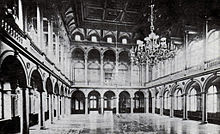New Exchange (Kaliningrad)
The New Stock Exchange was founded in Königsberg i. Pr. Built. Destroyed in World War II, the building was restored like few others in Kaliningrad in 1967. It is located on the southern bank of the old Pregel opposite the Kneiphof Island on the southern driveway to the Lenin Prospect elevated road . Since 2018 it has housed the Kaliningrad Museum of Fine Arts .
history
The stock exchange was built between 1870 and 1875 on the Green Bridge opposite the Kneiphof in the Northern Italian neo-renaissance style and was built according to plans by the architect Heinrich Müller from Bremen. At that time it was actually the New Stock Exchange as the successor to the Old Stock Exchange at the Grüner Tor , which existed opposite the Kneiphof until 1864 , and which had already had several previous buildings as a stock exchange in its place.
Because of the swampy subsoil, the building site had to be reinforced with 2200 oak piles 12 to 18 m in length. The exchange served in particular the domestic and international grain, seed and feed business as well as the related branches of freight, forwarding, storage and insurance.
The new stock exchange was the seat of the Chamber of Commerce to Konigsberg and Chamber of Commerce to Konigsberg . Concerts and political meetings were also held in this building. The most important social winter event was the stock market mask ball, at which large circles of the city, tradespeople, scholars, officers, civil servants and artists were present.
Until the destruction during the Second World War, sculptures from the four continents of Europe, Asia, Africa and America by the sculptor Emil Hundrieser adorned the four corners of the building. Only the two portal lions on the pedestals of the outside staircase survived the war as allegorical architectural decorations.
After the Second World War, the ruin was used as a backdrop in Soviet war films, for example in the 1964 film The Soldier's Father. After the building was declared an architectural monument in 1960 because its architectural style was considered to be artistically significant, and there found elements of Russian classicism , it was restored in 1967. Instead of the original ocher color, a bluish color was chosen, in keeping with the new function as a seafarers' cultural center (Dworez Kultury Morjakow).
In 2000 the Oblastnoi Zentr Kultury Molodeschi (Oblastnoi Zentr Kultury Molodeschi) moved into the building and returned to its original ocher color. In 2018, the Kaliningrad Museum of Fine Arts (Kaliningradski musei isobrasitelnych iskusstw) moved there. A park was set up on the side of the building facing away from the Pregel , which is called Birschewoi skwer (Börsenplatz).
literature
- Robert Albinus: Königsberg Lexicon. City and surroundings . Flechsig, Würzburg 2002, ISBN 3-88189-441-1 .
- Fritz Gause : The history of the city of Königsberg in Prussia. 3 volumes. 2nd / 3rd supplemented edition. Böhlau, Cologne et al. 1996, ISBN 3-412-08896-X .
- Fritz Gause : The history of the city of Königsberg in Prussia. 3 volumes. 2nd / 3rd supplemented edition. Böhlau, Cologne et al. 1996, ISBN 3-412-08896-X .
- Jürgen Manthey : Königsberg - history of a world citizenship republic . Hanser , Munich 2005, ISBN 3-446-20619-1 .
- Gunnar Strunz: Discover Königsberg. Between Memel and fresh lagoon . Trescher, Berlin 2006, ISBN 3-89794-071-X .
Web links
Remarks
- ^ Quote from Gunnar Strunz: Königsberg, Kaliningrad region. 2012, p. 133.
Coordinates: 54 ° 42 ′ 18.3 " N , 20 ° 30 ′ 27.3" E



